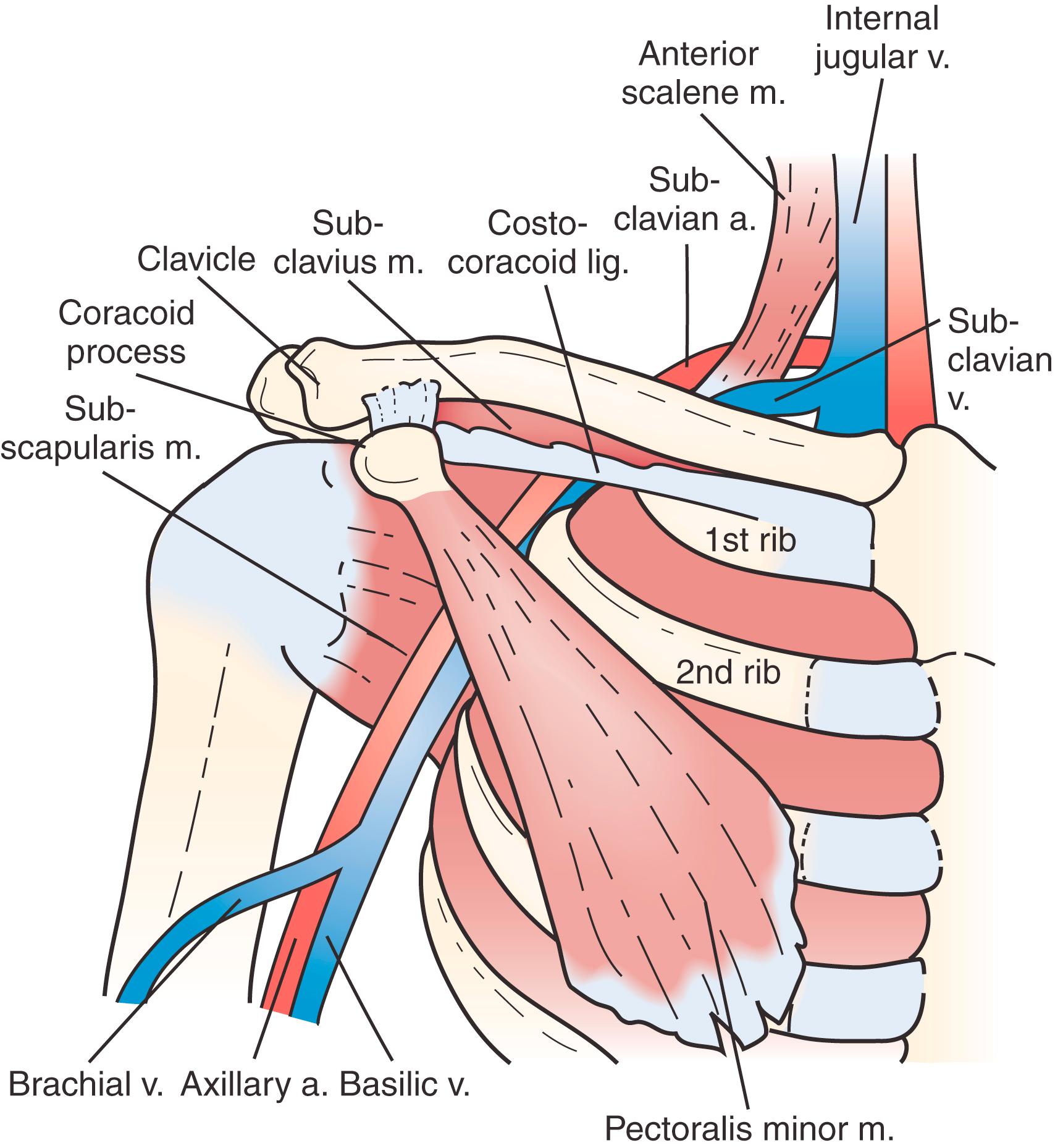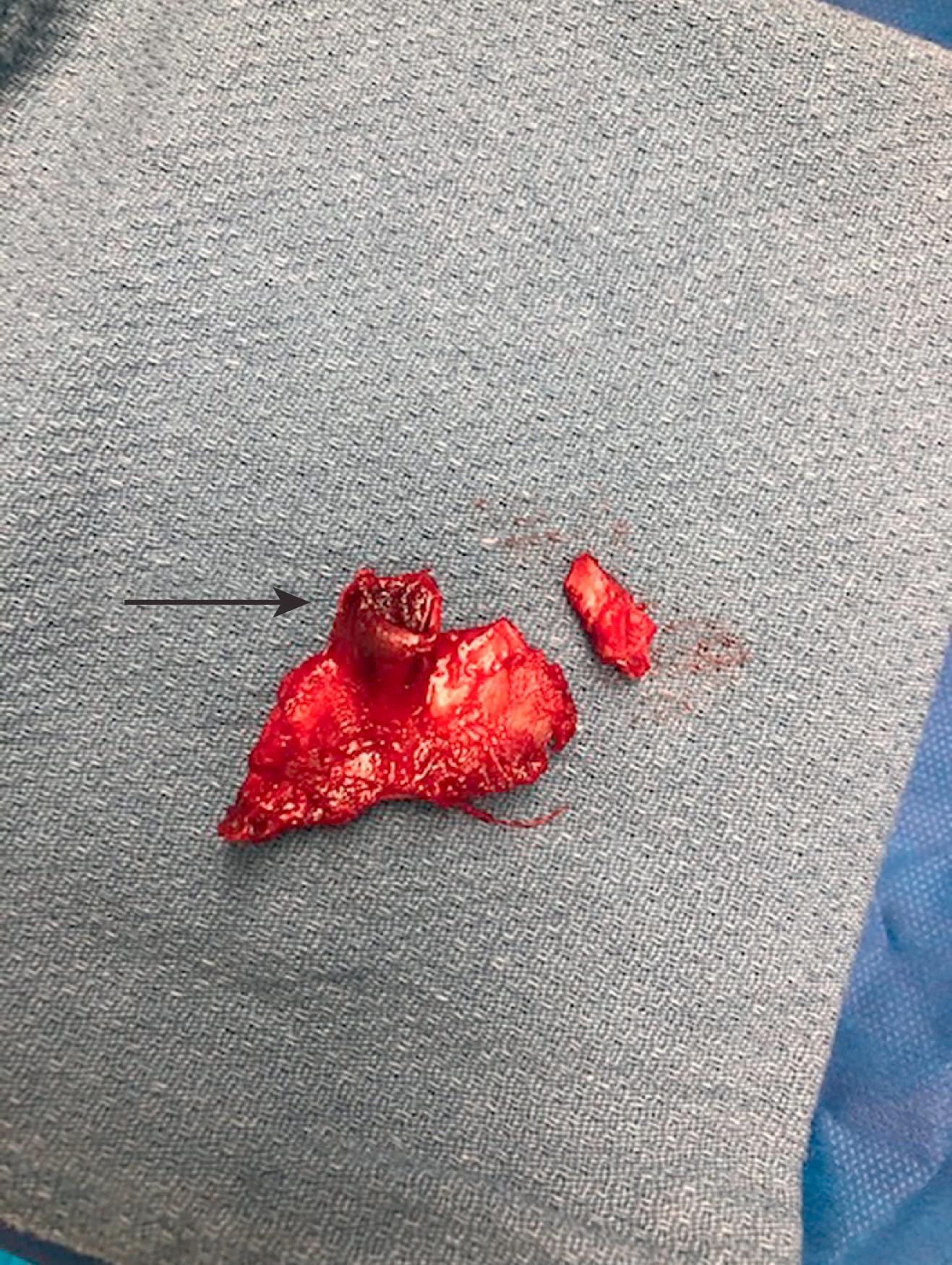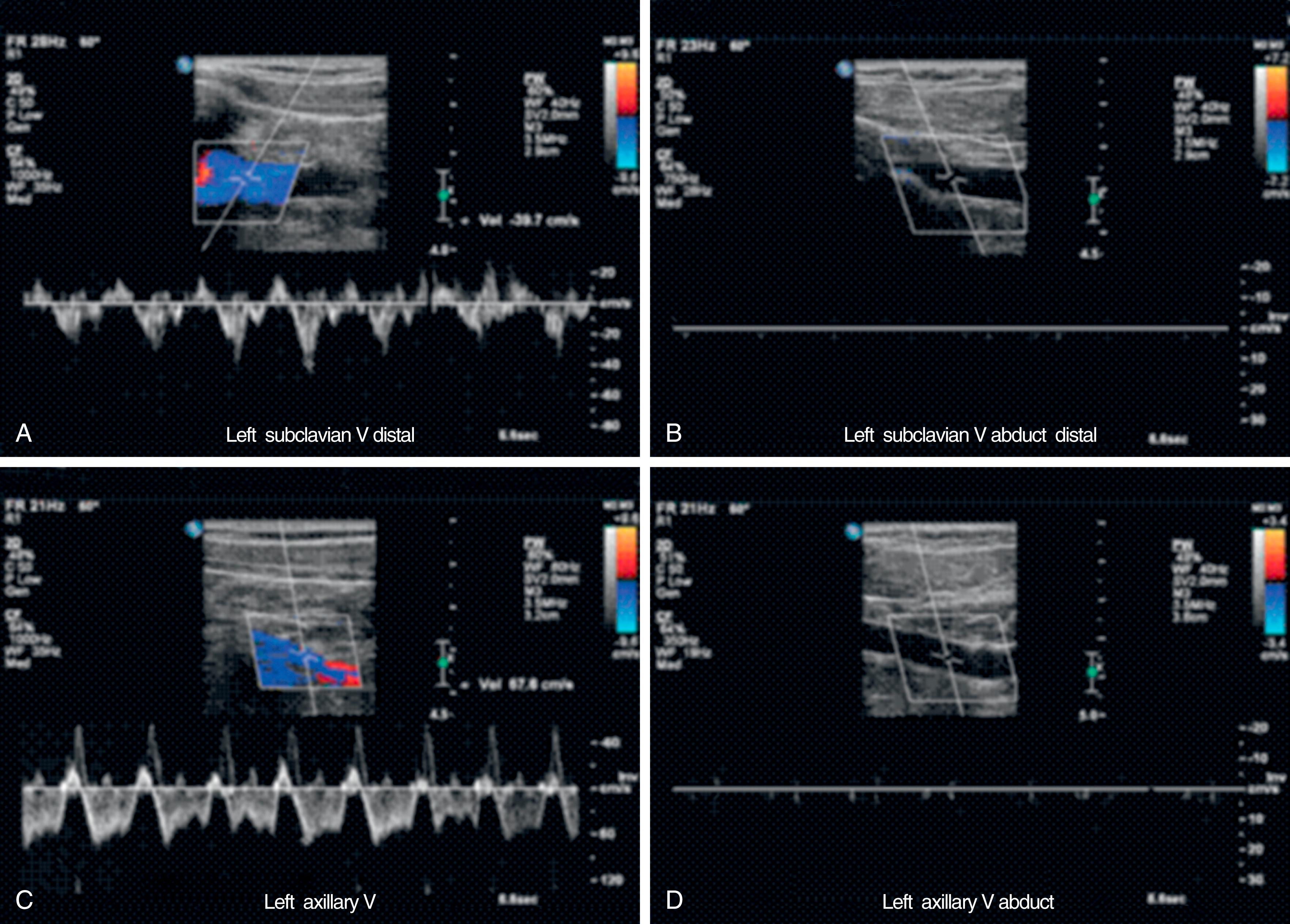Physical Address
304 North Cardinal St.
Dorchester Center, MA 02124
Venous thoracic outlet syndrome (vTOS) is thrombosis or severe stenosis of the subclavian–axillary vein secondary to chronic extrinsic mechanical compression. Most commonly, this stems from acquired anatomic changes in the thoracic outlet including anterior scalene or subclavius muscle hypertrophy or from previous bony trauma to the anterior chest. vTOS is the second most common form of thoracic outlet syndrome (TOS). Paget described the original disease process in 1875 as a syndrome of acute arm swelling and pain. He hypothesized the disease was due to vasospasm. In 1884, von Schroetter described the symptoms of acute upper extremity pain and swelling as a result of subclavian and axillary vein thrombosis. The eponym Paget–von Schroetter syndrome was first coined by Hughes in 1949 after a comprehensive review of the world’s literature related to thrombosis of the subclavian and axillary veins. vTOS has also been described as effort thrombosis , which describes the association with young healthy individuals who engage in activities requiring repetitive arm and shoulder motion such as athletics or certain occupations.
Upper extremity deep venous thrombosis (DVT) represents approximately 9% of reported episodes of DVT (see Ch. 150 , Acute Upper Extremity and Catheter-Related Venous Thrombosis). Subclavian–axillary vein thrombosis in vTOS is a direct result of repetitive injury to the subclavian vein at the level of the costoclavicular space, the most anterior and medial aspect of the thoracic outlet ( Fig. 126.1 ). The key anatomic structures resulting in compression of the subclavian vein are the first rib, the clavicle with its associated subclavius muscle and fibrous costocoracoid ligament, and the anterior scalene muscle/tubercle. , A cycle of alternating post-traumatic inflammation and quiescence leads to perivenous fibrosis, endothelial injury, stasis of blood flow, and thrombosis.

Although vTOS has been reported to occur in the absence of any identifiable anatomic abnormality, , a diverse array of anomalies associated with the thoracic outlet has been reported at the time of surgery. These include abnormalities of the soft tissues including the anterior scalene muscle, the subclavius tendon, or the presence of scalenus minimus muscles. Other abnormalities include bony abnormalities of the clavicle and ribs as well as ligamentous abnormalities of the costocoracoid ligament. , While commonly associated with other forms of TOS, the presence of cervical ribs can also be a cause of vTOS. In one of the largest retrospective series of TOS patients undergoing surgical intervention, Orlando et al. found that cervical ribs were associated with 68% of arterial TOS cases, 9.4% of neurogenic TOS cases, and only 2.3% of vTOS cases. Similarly, Weber and Criado. found that cervical ribs were only associated with 2% of vTOS cases in their retrospective series. Post-traumatic changes following clavicular or first rib fractures are also commonly reported, with callus formation at the clavicle and pseudoarthrosis of the first rib being a potential source of thoracic outlet compression ( Fig. 126.2 ).

Frequently, compression of the subclavian vein occurs at the costoclavicular space without the development of thrombosis. This point is underscored by venographic studies evaluating the contralateral subclavian vein in patients with confirmed subclavian–axillary vein thrombosis. Although narrowing of the contralateral vein with provocative measures is visualized in 56% to 80% of contralateral limbs, the incidence of bilateral thrombosis is markedly less, at 2% to 15%. ,
Because venous compression at the thoracic outlet can be caused by a multitude of primary factors, the Society for Vascular Surgery (SVS) has issued reporting guidelines to help facilitate data acquisition and analysis. In the case of venous compression, all venous compression in which the pathophysiologic etiology involves the costoclavicular junction is classified as vTOS whereas those that occur at the pectoralis minor space are classified as VPMS (venous pectoralis minor syndrome). Patients in which the venous compression occurs at both spaces are classified as vTOS/vPMS.
Described in 1951 by McCleery and colleagues, this syndrome represents intermittent obstruction of the subclavian vein without thrombosis. The pathology results from compression of the vein between the subclavius tendon and the anterior scalene muscle that is worsened with arm abduction ( Fig. 126.3 ). This syndrome manifests with blue discoloration of the arm, superficial venous distention, and swelling. Despite the lack of venous thrombosis, these patients are usually limited in the use of the affected extremity and should be treated with surgical decompression.

Although vTOS typically refers to primary subclavian–axillary vein thrombosis, the differential diagnosis should include secondary upper extremity DVT. Issues associated with secondary upper extremity DVT include nephrotic syndrome, mediastinal tumors, malignancy, local surgery or trauma, hypercoagulable states, renal failure requiring dialysis, long-term use of peripherally inserted central catheters, and cardiac conditions requiring pacemaker placement. The two most common causes of mechanical secondary upper extremity DVT are the placement of central venous catheters and pacemaker wires.
Catheter-related venous thrombosis occurs in 5% or less of all inserted central venous catheters. , Risk factors associated with a higher rate of catheter-related thrombosis in adult patients are catheter-related (malposition of the catheter, insertion of the catheter on the left, multiple catheter lumens), treatment-related (use of long-term antibiotics or total parenteral nutrition, bolus vs. dilute chemotherapy infusions), or patient-related (malignancy or hypercoagulable states). Patients with catheter-related venous thrombosis can be asymptomatic, but significant symptoms such as pulmonary embolism can occur in as high as 15% to 25% of patients. It is important to remember that the rate of thrombosis is not necessarily due to the duration of catheter placement.
In addition to catheters, pacemaker wires are an increasing cause of secondary subclavian–axillary vein thrombosis. The number of leads, previous use of a temporary pacemaker, and left ventricular ejection fraction ≤40% are predictive of venous stenosis. , Infection of the pacemaker insertion site has also been shown to increase the risk of venous stenosis and occlusion. The use of anticoagulation is protective against the development of occlusion of the subclavian vein but has not been shown to prevent venous stenosis.
As in the case of primary upper extremity vTOS, the pathophysiology of secondary upper extremity subclavian–axillary thrombosis is vein wall damage. In some cases, catheter removal causes the fibrin sheath to break loose and subsequently embolize into the pulmonary circulation.
The mean age at diagnosis for vTOS is 32 years, with the majority of patients affected between the second and fourth decades of life. However, Orlando et al. have found that the mean age of patients being treated for vTOS may be trending to younger individuals. This may be attributable to more intensive athletic pursuits in younger individuals. Despite early reports showing a female predominance, more recent literature, including the largest series published to date (312 affected extremities), has reported an equal gender ratio. , , Individuals who perform strenuous or sustained upper extremity activities, whether athletic or occupational, are particularly prone to the development of subclavian–axillary vein thrombosis. The dominant arm is involved in the majority of cases. , While not necessarily associated with primary hypercoagulable conditions, vTOS can be the initial presentation of venous thromboembolism in patients with underlying hypercoagulable conditions. In their retrospective review of 143 patients, Likes et al. found an underlying hypercoagulable condition in 25% of vTOS patients who underwent hypercoagulable testing.
Upper extremity edema is the hallmark finding associated with subclavian–axillary vein thrombosis. The edema is often, but not always, accompanied by pain and cyanosis of the affected extremity. The edema usually involves the shoulder, arm, and hand, and is characteristically non-pitting. Occasionally the associated discoloration of the extremity can be confused with cellulitis, delaying the diagnosis of vTOS. Dilated superficial veins over the shoulder, neck, and anterior chest wall can often be visualized as collateral veins try to accommodate the increased venous pressure (a pattern often referred to as first rib bypass venous collaterals ). A minority of patients may demonstrate symptoms resembling neurogenic TOS, such as numbness and tingling in the distribution of the inferior trunk of the brachial plexus. This association is likely due to the presence of muscular anomalies of the thoracic outlet anatomy and the performance of repetitive upper extremity arm activities.
Patients may report some degree of pain. The description can include aching, stabbing, or a feeling of tightness that worsens with exertion. Extended use of the arm leads to increased arterial blood flow, for which the limited collateral venous bed is unable to compensate. The subsequent venous hypertension worsens symptoms of venous stasis and arm congestion. Urschel and Razzuk reported that among 312 patients with extremities with vTOS in their 30-year experience, 93% complained of arm swelling, 77% demonstrated bluish discoloration, 66% had aching pain with exercise, and 8% were asymptomatic. Similarly, Van Rooden et al. reported that 52% of patients were symptomatic, 39% were completely disabled, and 9% were asymptomatic.
The two most potentially severe complications of subclavian–axillary vein thrombosis are pulmonary embolism and upper extremity phlegmasia cerulea dolens (venous gangrene). The reported incidence of a pulmonary embolism due to subclavian–axillary vein thrombosis is less than 10%. , , , , Compared with iliofemoral DVT, the small clot burden of upper extremity DVT may reduce the clinical impact of pulmonary embolism. Venous gangrene is exceedingly rare and has been limited to case reports in patients with malignant disease or an underlying hypercoagulable state. No reports of venous gangrene occurring secondary to vTOS have been published.
The diagnosis of vTOS is most often suspected after the performance of a thorough initial history and physical examination. Acute swelling, cyanosis, and pain in an isolated upper extremity of a young, active patient is the hallmark presentation. Typically, due to the acute nature of the presentation, the physical exam findings will consist of swelling from the shoulder to the hand that is often pronounced and can be up to twice the patient’s normal arm diameter. These patients will typically have multiple collateral veins that can be visible on the chest. In older patients, other etiologies must also be considered including lymphedema and malignancy. In patients with clinical suspicion for vTOS, subsequent imaging is mandated to help confirm the diagnosis.
While historically relevant, the utilization of provocative maneuvers for the diagnosis of vTOS, are not as useful when compared to other forms of TOS. Adson’s test (loss of radial pulse during hyperabduction maneuvers), traditionally described as a test to evaluate for thoracic outlet compression, is highly inaccurate in the diagnosis of vTOS as it can be positive in up to 40% of the normal population. Likewise, the elevated arm stress test (EAST), while very sensitive in neurogenic TOS, is not useful in the diagnosis of vTOS.
In those patients who have physical exam findings consistent with vTOS, a more objective workup is necessary. Duplex ultrasonography is the most frequently used diagnostic modality for the evaluation of patients thought to have DVT of the upper limb (see Ch. 25 , Vascular Laboratory: Venous Duplex Scanning). The study is noninvasive, does not require the use of a nephrotoxic contrast agent, and does not involve ionizing radiation. In addition, it can be performed at the bedside or in the emergency department. The use of diagnostic ultrasound in the upper extremity is different from that in the lower extremity. Overlying structures, such as the clavicle, make duplex interrogation of the vascular structures coursing through the thoracic outlet challenging. In the upper extremity, the compressibility of the targeted vein is not possible beneath the clavicle, nor is it possible to compress the brachiocephalic vein or superior vena cava. Therefore duplex examinations relying on B-mode ultrasound alone have historically demonstrated low sensitivity (54%) and high specificity (100%) for the detection of subclavian–axillary vein thrombosis. The standard use of color-flow duplex imaging in conjunction with indirect criteria suggesting the presence of an occlusion (evaluation for phasicity of flow with respiration and augmentation with compressive maneuvers) have led to markedly increased sensitivity (81% to 100%) while maintaining high specificity (82% to 100%). However, with false-negative rates as high as 30%, a negative duplex examination should not exclude the diagnosis of vTOS in patients who have physical exam findings consistent with the disease. Findings that may suggest subclavian–axillary thrombosis include loss of flow in the subclavian vein, loss of phasicity in the axillary vein, or evidence of acute thrombus on B-mode imaging. Provocative positioning, such as external rotation and abduction of the upper extremity can allow for dynamic phlebography to help facilitated diagnosis. Likewise, the differentiation between McCleery syndrome and subclavian–axillary thrombosis can be achieved with dynamic imaging. ,
Magnetic resonance venography (MRV) and computed tomographic venography (CTV) are additional noninvasive imaging modalities that have been used with increasing frequency for the diagnosis of vTOS. , The sensitivity and specificity of both modalities are comparable to those of duplex ultrasound. CTV has the added advantage of being able to detect central vein thrombosis and the presence of pulmonary emboli, with appropriate arterial timed contrast. Similarly, CTV is very accurate in the detection of mechanical obstruction or occlusion of the subclavian vein at the thoracic outlet, the presence of collateral venous drainage, and the presence of chronic thrombus. However, MRV and CTV are rarely necessary for patients with suspected vTOS. The cost and time required for completion of the examination are substantial. MRI is routinely used in patients with neurogenic TOS, as dynamic MRI can identify the location and etiology of brachial plexus compression, as well as associated vascular compression.
Become a Clinical Tree membership for Full access and enjoy Unlimited articles
If you are a member. Log in here